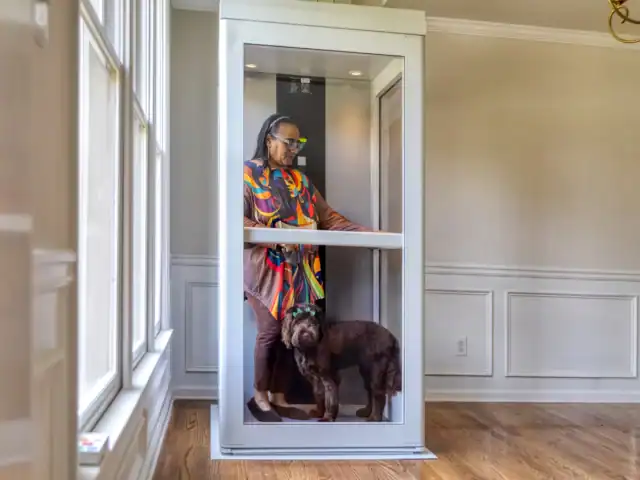Elevating Independence: How Residential Elevators Support Safer, Smarter Living for Your Clients
October 7, 2025

When it comes to helping clients live safely and confidently at home, physical and occupational therapists play a crucial role in connecting accessibility goals with real-world solutions. From stairlifts and ramps to full home elevators, the right adaptive equipment can transform independence and daily function.
While once considered a luxury, home elevators have evolved into practical, compact, and surprisingly affordable tools for enhancing mobility, safety, and quality of life—especially for those recovering from injury, managing chronic conditions, or planning to age in place.
Residential elevators can also be retrofitted into the home – shaftless elevators, like the Pollock Residential Elevator, require minimal construction in the home, have a small footprint, and are more cost-effective than products that require hoistways or assisted living facilities.
Below are five ways residential elevators can complement your therapy plans and improve client outcomes.
1. Reduce Fall Risk and Physical Strain
For clients with balance challenges, limited mobility, or fatigue, stairs are among the most dangerous areas in a home. A residential elevator eliminates the need for climbing, reducing both fall risk and joint strain.
Ideal candidates include clients with:
- Arthritis or joint replacements
- Neurological disorders (e.g., Parkinson’s, MS, post-stroke)
- Limited endurance or post-surgical restrictions
By integrating elevator recommendations into home assessments, therapists can create safer, fall-resistant living environments that promote long-term independence.
2. Empower Clients to Age in Place
As more adults choose to age in place, accessibility becomes essential to sustaining independence. Home elevators provide future-proof mobility that adapts to changing health needs—allowing clients to stay in their homes comfortably without constant remodeling.
Unlike stairlifts or platform lifts, elevators accommodate walkers, wheelchairs, or caregiving assistance, offering a dignified, barrier-free experience. For therapists, this means helping clients plan, rather than react to mobility loss later.
3. Improve Caregiver Safety and Efficiency
Caregiver injuries often occur while assisting clients up or down stairs. Elevators ease those physical demands by making multi-level transfers faster and safer—reducing strain on both the caregiver and the patient.
For home health professionals, this translates to better ergonomics, fewer injuries, and higher quality of care.
4. Enhance Client Confidence and Daily Function
Restoring independence is about more than physical strength—it’s about confidence. With a home elevator, clients can regain control of their environment, participating in daily routines they may have once avoided due to safety concerns.
Therapists can even use elevator-assisted movement as part of functional mobility retraining, encouraging clients to safely retrieve items, move between therapy zones, or access outdoor areas. Many models offer smooth, quiet rides that reduce motion anxiety—ideal for clients with vestibular or balance sensitivities.
5. Seamless Integration with Modern Home Design
Modern residential elevators blend style with accessibility, offering customizable finishes and compact footprints that fit into almost any home. From pneumatic vacuum elevators to sleek hydraulic models, these systems provide flexibility for both new builds and retrofits.
Partnering with certified installers ensures each solution meets the user’s unique mobility profile, space requirements, and safety standards.
The Therapist’s Takeaway
As mobility experts, physical and occupational therapists are uniquely positioned to identify when a home elevator could prevent injury, reduce caregiver strain, or extend a client’s independence. Recommending one as part of an accessibility and fall-prevention plan can make a lasting impact on a client’s quality of life—without compromising aesthetics or budget.
Explore More
To learn how modern elevator technology can support your clients’ independence, visit the Elevator Buyer’s Guide, read more about Pollock Lifts here, or meet with a certified dealer/installer near you.


